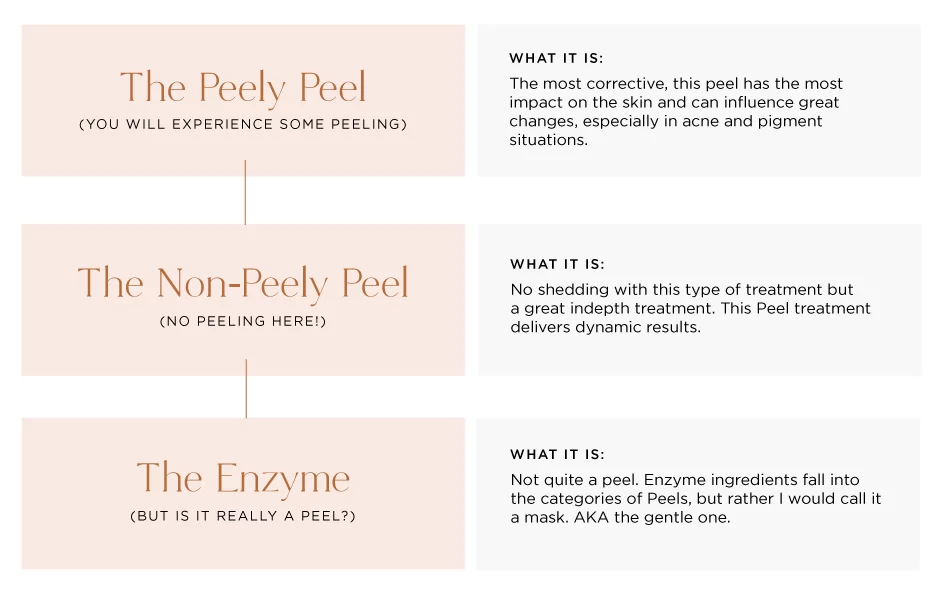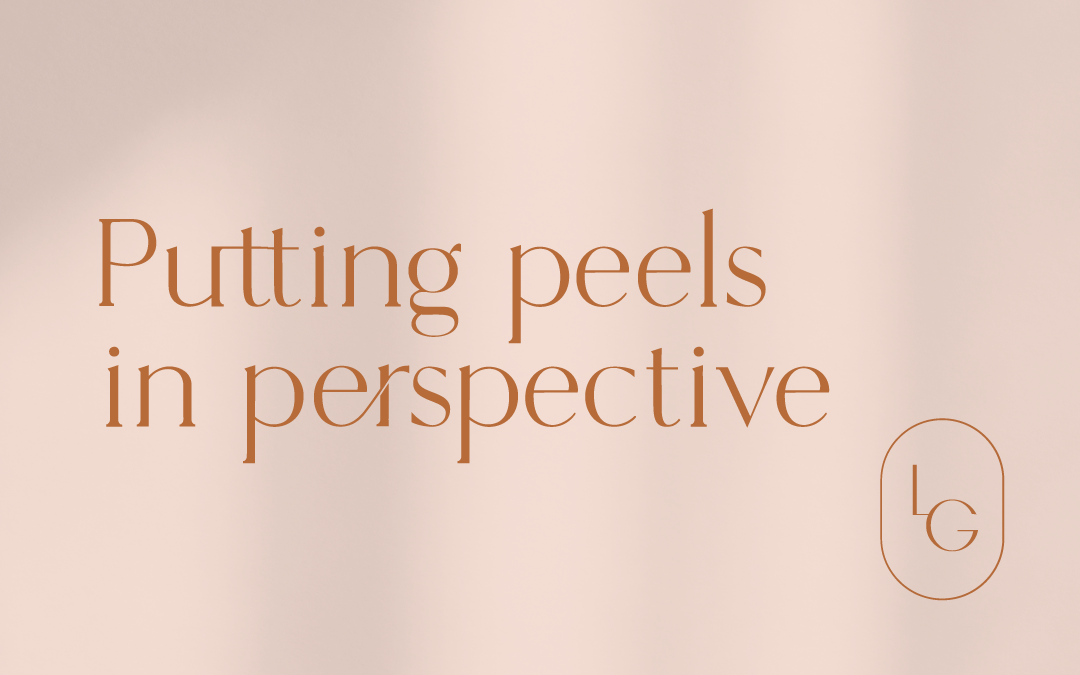I’m going to put it out there: the term Chemical Peel doesn’t really mean much. As a broad sweeping euphemism, it implies an action on the skin. Where it gets confusing and a bit messy to understand is because of the connection made between the term Chemical Peel and the different kinds of ingredients used.
I want to lay out the different types of peels you can choose from. Rather than diving into the ingredients, the goal here is to position peels for you. To make sense in plain language and put all this peel business into perspective.
“Where it gets confusing and a bit messy to understand is because of the connection made between the term Chemical Peel and the different kinds of ingredients used.”
What Is a Chemical Peel?
A chemical peel is a treatment
Pure acids, acids blended together, and enzymes (confusing, but we will get to that), are referred to as peels. But in truth, they are the ingredients that perform the peel – or do the work.
During a chemical peel, acid ingredients are applied to break down layers of dead skin, revealing fresh skin underneath. The potential result you can achieve will depend on the level and type of chemical peel performed.
Understanding the differences between different chemical peels comes down to the type, combination and strength of acids used. That’s my big opener. Good so far?
There are different depths of chemical peel treatments
The type of ingredient, and blend of ingredients will determine the depth that it works at. To understand the different depths, let’s look at the Peel Hierarchy.
Peel Hierarchy
Not all peels are equal – they work in different ways.
It is important to understand that there are different ingredients, in strength and combination or blends that work at different levels on the skin in a chemical peel treatment.
Pure acids are the ingredients applied to the skin in a chemical peel (ie. AHAs like glycolic, lactic, BHAs like salicylic to name a few). The concentration and blend will determine the depth of treatment and skin response.
Different peel ingredients will cause different reactions on the skin. A clear way to distinguish the impact is whether you peel or not.
Before we dive in: there are two types of peels – the peeling kind, and the non-peeling kind. It is important to also know that the type of peels we are talking about are surface level or superficial peels and only penetrate at the dermal level. They are considered the safest and the most controlled to work with.

From most ‘active’ to least active, here’s how I rank the Peel Hierarchy.
1. The Peely Peel
What it is: At the top of the hierarchy, this is the chemical peel that everyone fears, mostly because of the peeling that can occur. When we say peel, this is the most commonly indicated.
This is the only peel where the product – a blend of acids – is left on the skin and self neutralizes over 24 hours.
The most corrective, this peel has the most impact on the skin and can influence great changes, especially in acne and pigment situations.
The skinny: When this treatment is done you usually look like a million bucks!
Peeling/shedding occurs around day 2-3 and lasts for a couple of days. By day 6/7 you are through and super glad you did it.
To achieve a true corrective result a series of 3 or more treatments are required, depending on the level of concern/issue.
2. The Non-Peely Peel
What it is: This might seem kind of like a non-event after all the hoopla of the Peely Peel.
An individual acid or low concentration blend of one or two is applied to the skin; and is removed or neutralized after.
Therefore, there is no shedding with this treatment but it is still a great in-depth treatment
The skinny: I love this type of peel!
This peel treatment delivers dynamic results. It goes levels far beyond your ‘Spa Facial’ to have that ‘glow on’ effect – without any post treatment peeling.
Cool fact: This type of treatment is what drew me to the idea of impactful medical facial treatments. Serious results without serious intervention.
3. Enzyme – Is it really a peel?
What it is: Is it really a peel? I don’t think so.
Enzyme ingredients fall into the categories of peels, but rather I would call it a mask. AKA the gentle one.
Usually found in fruit enzymes such as papaya or pineapple – they both exfoliate and nourish the skin.
The skinny: Enzyme ingredients are a great pre-treatment vehicle to prep the skin before a peel, whether the peely type or not. By removing the first layer of surface debris, it preps the skin for better results from the chemical peel.
In professional format, it works well on skin that is not yet ready for anything stronger.
Finding The Peel That Works For You
There you have it, to peel or not to peel, really is the question.
What level of work do you want to do on the skin and what are you willing to put up with? If you have serious concerns that you want to address, such as acne, pigmentation or uneven texture, Peel #1 (the peely kind) is going to get you there. This type of peel does amazing things for the skin.
If you want to do some good clean up work then Peel #2 (the non-peely peel) is perfect.
Choosing what is best for your skin is a challenge to say the least. That is why I take the time for meaningful consultation and conversations with you first.
As your skin care expert, I can see the complete picture and will figure out all the pieces for you, leaving you to enjoy the result – beautiful skin you’ll love.
Want to book in for a treatment, or looking for a consultation? Reach out.

